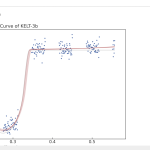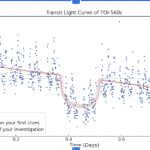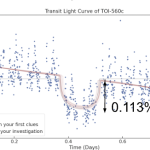
Project Gallery 2023
Secondary students from across Europe became exoplanet detectives with ESA and used Cheops satellite data to uncover the mysteries of two exoplanet targets: KELT-3b and TOI-560c.
Explore the projects below.
Liger
Best Project Prize Winner
International School of Lausanne Lausanne – Vaud Switzerland 15 years old 2 /
KELT-3b
KELT-3b project description:
Since the beginning of civilizations, humans have been intrigued by the celestial bodies seen up in the sky. They have wondered and strived to understand them resulting in a dedicated stem of science known as Astronomy. Yet it was only with discovery of large telescopes and technology that deep space research became a reality in the 20th century. Today with the advent of AI and Science of big data, we now can spot celestial bodies and exo-planets directly by analyzing the data from satellites, space probes, telescopes, etc. One such celestial body is KELT – 3b, an extrasolar planet orbiting the F-type main-sequence star KELT-3, 690 light years in the zodiac constellation Leo, discovered in 2013 by KELT’s telescope in Arizona
Goal for this study is to analyze the data collected by ESA’s Cheops (CHaracterising ExOPlanet Satellite) satellite in 2023 to find its
- size
- distance from its Host star
- temperature and its habitability
- composition
Supporting files:
TOI-560c
TOI-560c project description:
Since the beginning of civilizations, humans have been intrigued by the celestial bodies seen up in the sky. They have wondered and strived to understand them resulting in a dedicated stem of science known as Astronomy. Yet it was only with discovery of large telescopes and technology that deep space research became a reality in the 20th century. Today with the advent of AI and Science of big data, we now can spot celestial bodies and exo-planets directly by analyzing the data from satellites, space probes, telescopes, etc. One such celestial body is TOI – 560C, an extrasolar planet orbiting a small orange star called the Hd 73583, 177 light years in the zodiac constellation Hydra, discovered in 2021 by TESS survey.
Goal for this study is to analyze the data collected by ESA’s Cheops (CHaracterising ExOPlanet Satellite) satellite in 2023 to find its
size
distance from its Host star
temperature and its habitability
composition
TOI-560c Results and Analysis
Method
For this study, the data used was the one gathered by ESA’s CHEOPS satellite in 2023. CHEOPS used the Trans photometry method, that measures the dip in the brightness of the star, to see whether an exoplanet has passed or not. We analyzed the data points gathered by CHEOPS and using the ALLESfitter software calculated the size of the planet, size of the star, trans period – which was used to find the distance of the planet from its host star and the orbital period. We also estimated the temperature and the habitability of the planet by using the trans period
Analysis of the data using Allesfitter
Refer to the the image files and project report attached
Results and findings: From the graph mentioned above, we found
1. The size of TOI – 560C
We have the Median value of the radius of the planet, the radius of the sun, and the time taken for the planet to pass across the star. With this data we can find its transit depth from the transit light curve, which is the amount of light that the exoplanet blocks when passing in between the sattletie and the star using below formula : Tr = (𝝅*Rp2/𝝅* Rs2) * 100
From the case file we get, Rp (Radius of planet) = 2.386 x Radius of Earth = 2.386 x 6371 Km and Rs (stellar radius) = 0.654 x Radius of Sun = 0.654 x 696,340 Km
Therefore Tr = 0.113%
Now plugging in Stellar radius and the Transit depth back to the equation, we can find the exact Radius of the exoplanet Rp.
Rp = Rs2* Tr/100 = 2.834 x Radius of Earth = 2.834 x 6371 Km
Therefore the Radius of TOI 560C Rp = 15191.66104 Km
2. Orbital distance
The Orbital period and distance can be found by using the orbital transit time (T). From the data we collected, we find that T= 0.4415 days . Rearranging the Kepler’s law of Period i.e. T2= (4𝝅2/GMs)d3, where T is the transit time, G is the gravitational constant, Ms is the mass of the star and d is the distance between the star and planet, we get the equation, d = 3GMs/4𝝅2 * T2
Plugging G= 6.7×10−11 Nm2Kg-2 , Ms =1.96 x Msun =1.96 x 3.90×1030 Kg and T=0.4415 days, we get the distance between the star and TOI 560C
d = 2.2466x 109m or 0.0015 au ( astronomical unit)
3. Temperature and habitability
We know that TOI 560 C is very close to its host star. Referring to the exoplanet.eu/catalog, we know that the temperature of TOI 560C is 503 ‘K or to be 230‘C
Being near to the host star it would be exposed to very high radiation. With such high temperature and high radiations, its surface becomes inhabitable. Hence TOI 560C would be inhabitable for humans.
4. Composition
The composition of a planet is the type of material that it is made of. This is determined through its mean density.
Density can be defined as ρ = Mp/Vp
where M is the mass of the planet and V is the volume of the planet.
The Mass of the planet using the Radial velocity method is given in the case file as
Mp = 9.7 ± 1.8 x Mass of earth = 9.7 ± 1.8 x 5.972 x 1024 Kg = 5.593 x 1028 g
Volume of the planet Vp= 4/3 𝝅 r3, where r is the radius of the planet
Since r = 2.386 x Radius of Earth = 2.386 x 6371 Km = 15191.66104 Km
Hence Vp= 1.488 x 1028 cubic cm
By plugging the Volume and the mass into the equation, we find
ρ = 3.891 g/cm3
With such high density compared to the Earth or other rocky planets, we can tell that TOI 560C is primarily a rocky planet
TOI-560c Conclusions
TOI 560C is a primarily a giant rocky planet with a radius of 15191.66104 Km (2.384 times the radius of Earth, making it around the size of Neptune). Its surface temperature is as high as ~230 ‘C. Its stellar distance is 0.0015 au making it very near to its host star. And hence it is exposed to high radiation making it inhabitable for humans
Supporting files:








